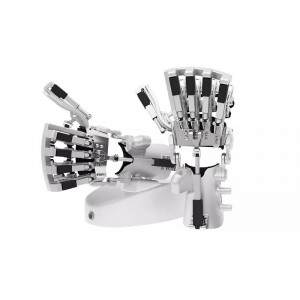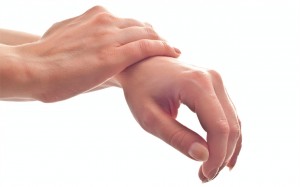For most stroke patients, they can regain the ability to stand and walk through active rehabilitation treatment. Systematic rehabilitation exercises have an important impact on the recovery of limb function. It can not only prevent and reduce swelling, promote the healing of damaged tissues, but also relieve pain, prevent muscle misuse, disuse or excessive fatigue, avoid joint secondary damage, desensitize hypersensitive areas, facilitate sensory re-education and movement, reconstruct sensory function, etc., so that the injured hand can recover better. Actively participating in rehabilitation exercises can reduce swelling and adhesion of limbs, dilute the scarring of surrounding tissues, promote the healing of damaged tissues, reduce joint stiffness and muscle atrophy, and reconstruct limb sensations.
Manifestations of Early Hand Dysfunction
01/Edema
The condition of the early bedside patients is not stable, and most patients need transfusion and stay with intravenous indwelling needles. After the disease occurs, the patient’s hand and even forearm areas are swollen due to limb circulatory dysfunction, slow or blocked venous return/nutrient metabolism, pressure, improper posture and long-term infusion. At the same time, the degree of edema control is also the key to the recovery of hand function in the later stage, which helps to lay a good foundation for the prevention of shoulder-hand syndrome (edema, pain, dysfunction).
02/Shoulder Subluxation
Due to the dysfunction of the central nervous system, the muscle strength around the shoulder joint is weakened and the joint capsule is relaxed. At the same time, due to the weight of the limb, the humeral head cannot be maintained at the original position and is displaced. In addition, due to the non-professional nursing operations without early rehabilitation guidance at the early phase, dislocations are often caused by the ignorance of the affected limbs during the process of turning over and position shifts.
03/Motor Dysfunction
Patients suffer from varying degrees of paralysis in their limbs after a stroke. According to Brunnstrom motor function staging, the upper limb function of early stage patients mainly exists in stages I to II, which are characterized by decreased muscle strength, abnormal muscle tone (decreased/increased), and limited joint movement. Stage I: no voluntary movement, no movement of the hands and upper limbs; stage II: there’s associative reaction and associated movement, there’s only cooperative movement patterns in the upper limbs, only slight flexion of the hand, and there’s no voluntary movement.
04/Sensory Dysfunction
Sensory dysfunction affects the overall functional level of patients, and different types of sensory dysfunction have different effects on the function of stroke patients. In early bedside patients, sensory loss or disappearance is common, and the upper limb sensory distribution of patients is often a “decaying” sensory decrease from the proximal end to the distal end.
05/Disuse/Disuse Atrophy
In the early stage of stroke patients, due to various physical functions and the medical environment (such as in the intensive care unit), the patients cannot recover in time. The failure to actively carry out active and passive limb activities and professional rehabilitation intervention in the early stage resulted in a series of joint adhesions, muscle and tendon contractures caused by prolonged stay, resulting in disuse/disuse atrophy, which seriously affected the follow-up rehabilitation effect and outcomes of the patients.
Hand Function Rehabilitation Training Method
01 Strength Training
Strength training is also the main training module of hand function. It strengthens the muscle strength of the wrist or fingers through electrical stimulation or certain grasping movements and manual stimulation.
02 Joint Range of Motion Training
Through passive stretching or professional joint mobilization, the joint mobility of the metacarpophalangeal or interphalangeal joints can be restored to exert their functions.
03 Training to Reduce Muscle Tone
Especially after a stroke, the fingers are prone to curl and make a fist, which is mainly caused by the increased tension of the fingers’ flexor muscles. Thermotherapy, including wax therapy, Chinese medicine soaking or repeated stretching, can reduce the muscle tension of the flexor muscles.
04 Finger FlexibilityTraining
The most critical step is the training of finger flexibility. After the finger function reaches a certain level, the flexibility of the fingers can be increased by practicing finger-to-finger exercise or pinching objects exercise, which lays the foundation for the patient’s ability of daily living.
Intelligent Equipment for Early Hand Function Rehabilitation
Hand Function Passive Training Robot A5 is an intelligent passive hand function training equipment developed and manufactured by Yeecon Medical. It simulates human finger and wrist movement rules and offers patients passive rehabilitation training of finger and wrist joints. Composite passive training is available for single finger, multiple fingers, all fingers, wrist as well as fingers and wrists. A5 is applicable to:
1. Rehabilitation of joint function after hand and wrist injury;
2. Rehabilitation of joint stiffness and joint function after hand surgery;
3. Training of hand and wrist ADL (activity of daily living) after central nervous system injury.


Read more:
Hand Function Training & Evaluation System
Effective Hand Function Rehabilitation Method
What Roles Does Hand Rehab Robotic A5 Play in Hand Rehab?
Post time: Apr-12-2022







